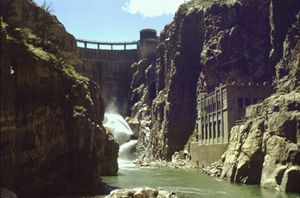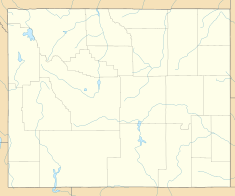Buffalo Bill Dam facts for kids
Quick facts for kids Buffalo Bill Dam |
|
|---|---|

Buffalo Bill Dam from within Shoshone Canyon
|
|
|
Location of Buffalo Bill Dam in Wyoming
|
|
| Official name | Buffalo Ridge |
| Location | Park County, Wyoming, US |
| Coordinates | 44°30′06″N 109°11′03″W / 44.50167°N 109.18417°W |
| Construction began | 1905 |
| Opening date | 1910 |
| Operator(s) | U.S. Bureau of Reclamation |
| Dam and spillways | |
| Type of dam | Concrete gravity arch |
| Impounds | Shoshone River |
| Height | 350 feet (110 m) |
| Length | 200 feet (61 m) |
| Width (crest) | 10 feet (3.0 m) |
| Width (base) | 108 feet (33 m) |
| Dam volume | 87,515 cu yd (66,910 m3) |
| Spillway type | Concrete lined tunnel through left abutment, radial arm gates |
| Spillway capacity | 84,725 cu ft/s (2,399.1 m3/s) |
| Reservoir | |
| Creates | Buffalo Bill Reservoir |
| Total capacity | 869,230 acre-feet (1.07218 km3) nominal, 623,557 acre-feet (0.769146 km3) due to siltation |
| Power station | |
| Hydraulic head | 265 ft (81 m) |
| Turbines | 1 x 3 MW Francis turbine, Unit 3 in Shoshone Powerplant 3 x 6 MW Francis turbines in Buffalo Bill Powerplant 1 x 5 MW Francis turbine in Heart Mountain Powerplant and 1 x 4.5 MW Francis turbine in Spirit Mountain Powerplant |
| Installed capacity | 30.5 MW |
| Annual generation | 91,114,580 KWh |
|
Buffalo Bill Dam
|
|
| Location | W of Cody on U.S. 14 |
| Nearest city | Cody, Wyoming |
| Built | January 15, 1910 |
| NRHP reference No. | 71000890 |
| Added to NRHP | August 12, 1971 |
The Buffalo Bill Dam is a large concrete dam on the Shoshone River in Wyoming, USA. It is named after the famous Wild West figure, William "Buffalo Bill" Cody. He founded the nearby town of Cody and owned much of the land now covered by the dam's reservoir.
The dam is part of the Shoshone Project. This project aimed to bring water to the Bighorn Basin. The goal was to change the dry, sagebrush-covered land into useful farmland. When it was first built, the dam was called Shoshone Dam. In 1946, it was renamed to honor Buffalo Bill Cody.
Engineer Daniel Webster Cole designed the dam, which stands 325 feet (99 m) high. It was built between 1905 and 1910. When it was finished, it was the tallest dam in the world. The dam was added to the National Register of Historic Places in 1971. In 1973, it was named a National Civil Engineering Landmark. The land around the reservoir is now Buffalo Bill State Park.
Contents
What is the Buffalo Bill Dam?
The Buffalo Bill Dam is a special type of dam called a concrete arch-gravity dam. This means it uses both its curved shape (arch) and its heavy weight (gravity) to hold back the water. The dam is 70 feet (21 m) wide at its base and 200 feet (61 m) wide at the top. Its original height was 325 feet (99 m).
The concrete structure is 108 feet (33 m) thick at the bottom. It gets thinner towards the top, measuring 10 feet (3.0 m) at the crest. It is built into very old, strong rock on both sides. The dam has a spillway on its south side. This is an uncontrolled overflow area, 298 feet (91 m) wide. Water flows through a tunnel in the rock next to the dam.
How Was the Dam Built?
Building the Buffalo Bill Dam was one of the first big projects for the new Bureau of Reclamation in 1904. This was a very ambitious project. It involved building one of the first tall concrete dams in the United States.
Work started right away in July 1904. Engineers drilled into the ground to study the rock. At the same time, a road was built up the narrow canyon from Cody. The first company hired to build the dam began work in September 1905. They set up a camp for workers. They also started building a temporary dam to move the river's water. This water was sent through a wooden channel and a tunnel.
Challenges During Construction
Building the dam was very difficult. Two workers died during the tunnel construction. A big flood in June 1906 destroyed the wooden channel. This caused delays, and the first company lost its contract. Another flood in July 1907 damaged the temporary dam again.
Working conditions were tough. In November, workers went on strike, demanding better pay. They successfully got three dollars a day. New companies took over the work in March 1908. Concrete pouring began in April. More spring floods caused work to stop again.
Despite the challenges, work picked up in March 1909. Another possible strike was avoided when new workers were hired. The last concrete was poured in January 1910. The total cost was about $1.4 million. Sadly, seven construction workers died during the project.
Early Issues and Solutions
After the dam was finished, it had some leaks. This caused low water levels in the reservoir, which led to dusty mudflats. Workers fixed the leaks by 1915. Some parts of the dam's water outlets were abandoned in 1959 and sealed in 1961.
The reservoir also started to fill with silt (fine dirt) from the river. This reduced its storage space. Work was done to build silt barriers and plant trees to help. Even with these efforts, the reservoir's capacity is now less than it was originally.
Power Plants and Tunnels
The Buffalo Bill Dam project includes several power plants and tunnels. These help generate electricity and move water for irrigation.
Shoshone Power Plant
Construction on the Shoshone Power Plant began in 1920. This power plant is located 600 feet (180 m) downstream from the dam. It is on the north side of the canyon. After some delays from spring floods, the power plant was ready in 1922.
The first two power units started working in 1922. A third unit was added in 1931. These units generated 6.012 megawatts of power. After fifty years of use, all three units were shut down in 1980. Units 1 and 2 were removed. Unit 3 was replaced with a new 3-megawatt unit, which started in 1992.
Shoshone Canyon Tunnel
The Heart Mountain Canal project needed a new tunnel. This tunnel would move irrigation water to a higher level for distribution. Work on the 2.8-mile (4.5 km) Shoshone Canyon Tunnel started in 1937.
During its construction, two tunnel workers died. They were overcome by fumes from explosives and natural gases. They were also hit by construction equipment. Workers had to build a concrete bridge inside a natural cave. This was very difficult due to the high gas levels. The tunnel was completed in 1939.
Heart Mountain Power Plant
The Heart Mountain Powerplant was built at the end of the Shoshone Canyon Tunnel in 1947. It was first a temporary facility. It was later rebuilt when the dam's height was increased. This plant runs seasonally and uses a 5-megawatt turbine.
Dam Renovation and Height Increase
Starting in 1985, the top of the dam was raised by 25 feet (7.6 m). This project finished in 1993. Raising the dam increased the reservoir's capacity by 260,000 acre-feet (0.32 km3). The spillways were also made larger and given new gates.
A visitor center was built at the north end of the dam's top. The extra height of the dam allowed for 25.5 megawatts of new power generation. Some parts of Buffalo Bill State Park had to be moved and rebuilt because the expanded reservoir covered them.
Buffalo Bill Power Plant
The Buffalo Bill Powerplant was built at the same time the dam's height was increased in 1992. This plant is located in Shoshone Canyon, downstream from the older Shoshone Powerplant. It uses three turbines, each generating 6 megawatts of power.
Spirit Mountain Power Plant
The Spirit Mountain Powerplant gets pressurized water through a pipe. Its main job is to reduce the water pressure before it enters an open canal. It generates power as a bonus. This plant uses a turbine to generate 4.5 megawatts of power. It operates seasonally and was built in 1994.
Images for kids






